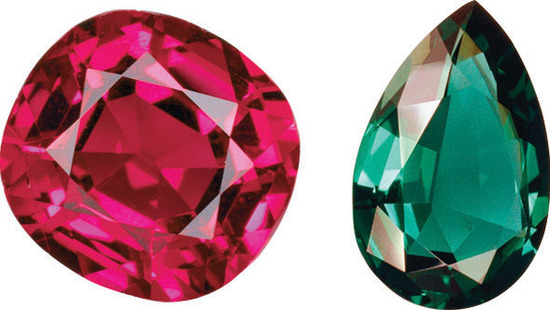25.1: The Colors of Rubies and Emeralds
- Page ID
- 47290
Why is a ruby red? The mineral corundum is a crystalline form of alumina: Al2O3. A pure crystal of corundum is colorless. However, if just 1% of the Al3+ ions are replaced with Cr3+ ions, the mineral becomes deep red in color and is known as ruby (Al2O3:Cr3+). Why does replacing Al3+ with Cr3+in the corundum structure produce a red color?
Ruby is an allochromatic mineral, which means its color arises from trace impurities. The color of an idiochromatic mineral arises from the essential components of the mineral. In some minerals the color arises from defects in the crystal structure. Such defects are called color centers.
The mineral beryl is a crystalline beryllium aluminosilicate with the chemical formula Be3Al2Si6O18. A pure crystal of beryl is colorless. However, if just 1% of the Al3+ ions are replaced with Cr3+ ions, the mineral becomes green in color and is known as emerald (Be3Al2Si6O18:Cr3+).
Why does replacing Al3+ with Cr3+ in corundum produce a red mineral (ruby) while replacing Al3+ with Cr3+ in beryl produces a green mineral (emerald)?
Recall that the color we observe when we look at an object or a compound is due to light that is transmitted or reflected, not light that is absorbed, and that reflected or transmitted light is complementary in color to the light that is absorbed. Thus a green compound absorbs light in the red portion of the visible spectrum and vice versa, as indicated by the color wheel. Because the energy of a photon of light is inversely proportional to its wavelength, the color of a complex depends on the magnitude of Δo, which depends on the structure of the complex. For example, the complex [Cr(NH3)6]3+ has strong-field ligands and a relatively large Δo. Consequently, it absorbs relatively high-energy photons, corresponding to blue-violet light, which gives it a yellow color. A related complex with weak-field ligands, the [Cr(H2O)6]3+ ion, absorbs lower-energy photons corresponding to the yellow-green portion of the visible spectrum, giving it a deep violet color.
We can now understand why emeralds and rubies have such different colors, even though both contain Cr3+ in an octahedral environment provided by six oxide ions. Although the chemical identity of the six ligands is the same in both cases, the Cr–O distances are different because the compositions of the host lattices are different (Al2O3 in rubies and Be3Al2Si6O18 in emeralds). In ruby, the Cr–O distances are relatively short because of the constraints of the host lattice, which increases the d orbital–ligand interactions and makes Δo relatively large. Consequently, rubies absorb green light and the transmitted or reflected light is red, which gives the gem its characteristic color. In emerald, the Cr–O distances are longer due to relatively large [Si6O18]12− silicate rings; this results in decreased d orbital–ligand interactions and a smaller Δo. Consequently, emeralds absorb light of a longer wavelength (red), which gives the gem its characteristic green color. It is clear that the environment of the transition-metal ion, which is determined by the host lattice, dramatically affects the spectroscopic properties of a metal ion.

Gem-quality crystals of ruby and emerald. The colors of both minerals are due to the presence of small amounts of Cr3+ impurities in octahedral sites in an otherwise colorless metal oxide lattice.

